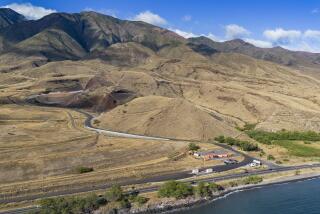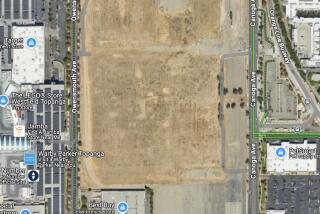Old Nuclear Dump Off Coast Is a Relic of Era of Naivete in Toxic Disposal
In the black depths of the ocean near the Channel Islands lies a largely forgotten memento of the early nuclear age. It is low-level radioactive waste generated at Rockwell Internationalâs Santa Susana Field Laboratory and Canoga Park plants.
For about a decade starting in the early 1950s, Atomics International, later part of Rockwell, dumped hundreds of drums of radioactive waste in 6,000 feet of water south of Santa Cruz Island.
Today, precise information on the dump is hard to come by. Old U.S. government reports estimate that the dump received about 3,100 drums of waste containing 108 curies of radioactivity--apparently not a great concentration considering the diluting power of the sea.
But it is not known if these numbers are accurate, or if all the dumping was recorded. Neither is it certain whether other government contractors disposed of waste at the site. Except for a limited survey in 1960, there has been no environmental monitoring of the Santa Cruz site by Rockwell or government agencies.
No Specific Studies
âAs far as we know, there have been no specific studies directed at that particular site to find out exactly what has been dumped there,â said Diane Green, a park naturalist with Channel Islands National Park.
âThe Park Service . . . does have concerns for that site as well as any other toxic dumping site,â she said.
Larger radioactive dumps used during the same years have been studied, specifically those near the Farallon Islands off San Francisco and in the Atlantic Ocean. Although elevated radioactivity was found in bottom sediment near these dumps, no significant levels were found in samples of fish. Most researchers have concluded that too little radioactive material was dumped off the U.S. coasts during the â40s, â50s and â60s to create a human health hazard.
The dumping was more of a dangerous precedent than a life-threatening event, said W. Jackson Davis, professor of biology at UC Santa Cruz and a leading critic of ocean disposal.
Other Waste
However, the dump may also be a special case because radioactive waste was not the only thing disposed of near Santa Cruz, the largest island in Channel Islands National Park. When Atomics International began the dumping, the Navy was already using the site to dispose of military waste. In fact, official nautical charts describe the site as a former âchemical munitions dumping areaâ--saying nothing about radioactive waste.
The radioactive waste dumping, authorized by the old U.S. Atomic Energy Commission, was variously estimated by Rockwell officials to have stopped between 1959 and 1962, when commercial land burial sites became available for low-level wastes generated at the Canoga Park plants and the Santa Susana Field Laboratory west of Chatsworth.
âThe ocean is awfully big,â and ocean dumping was considered âa perfectly acceptable way to dispose of radioactive waste,â said Marlin Remley, former chief of nuclear safety and licensing at Rockwellâs Rocketdyne division, successor to Atomics International. âI donât know when it was decided that, âHey, this is no good.â â
Atomics International dumped low-level material, including liquids, contaminated wipes, gloves, glassware and other equipment. But the refuse included some highly dangerous plutonium, according to a paper delivered by company officials at an AEC symposium in 1955.
Atomics International began the ocean dumping before moving to its plant at 6633 Canoga Ave. at the end of 1955. Previously it disposed of waste from experiments at its plant in Downey, where the firm operated Californiaâs first nuclear power reactor, a tiny test model, starting in 1952.
Although radioactive dumping by the United States virtually ended in 1962, it surfaced as a major environmental issue years later, leading to congressional hearings in 1976 and later.
According to information compiled at the time, at least 27 Pacific, Atlantic and Gulf Coast sites were designated for low-level wastes, but the waste dumped near the Farallons and at three Atlantic Coast sites far exceeded the volume at all other sites combined. Virtually all environmental monitoring by the Environmental Protection Agency and other organizations has been done at these larger sites.
Studies have found measurable radioactivity at each of the sites, but âwe didnât find any significant uptake of radioactive materials in any of the fish we sampled,â said Bob Dyer, chief of environmental studies for the EPA office of radiation programs in Washington.
Food Chain
Similar conclusions have been reached by contract researchers for the California Department of Health Services, who have gathered fish samples near the Farallon Islands during the last few years.
âThatâs the key thing you want to know,â Dyer said. âYou want to know whether itâs going up the food chain and getting into man, and thereâs no evidence of that.â
Dyer said that in 1960, an AEC contract research firm did a limited survey of the Santa Cruz dump and found no significant contamination.
According to the paper delivered by Atomics International at the AEC symposium, wastes were put in cylindrical ice cream cartons, which were placed in 55-gallon drums and sealed with concrete to make sure that they would sink to the bottom. About four times a year, the waste drums would be trucked to Long Beach for loading on a Navy barge.
The price could not be beat. âNo costs are involved since the dumping ground trip by the U.S. Navy is regularly scheduled for other purposes and ample space is availableâ on the Navy barge, the paper said.
Paid Overtime
But Atomics International paid overtime to its maintenance workers, several of whom accompanied each voyage. They would ride in the tug until it arrived at the dump, then take a small boat back to the barge to roll the drums over the side. The trip to the dump and back could take more than 24 hours, and the men were paid for every hour at sea.
James Youngblood of Santa Clarita, a retired Rockwell worker who went on two of the dumping trips, said this was a plum assignment and the men took turns because of the extra pay.
âI think they enticed the maintenance workers, the blue-collar workers, with the overtime pay,â said Eula Youngblood, his wife.
âWe just took it for granted it was a safe thing to do,â said Junius Wheeler of Lake View Terrace, a former maintenance supervisor who helped prepare the drums for disposal.
The volumes dumped may have increased after nuclear work shifted from Downey to Canoga Park sites and the Santa Susana lab, which have done extensive work with test reactors and nuclear fuel.
Firmâs Records
Company memos, provided by Rockwell in response to questions about the ocean disposal, allude to at least 10 dumping trips in 1958-59, including the disposal in September, 1958, of 225 55-gallon drums along with contaminated boxes, tanks and conduits.
Sometimes the company hired commercial haulers, but a problem arose with the private firms. Just as the operation involved old ideas of pollution control, so did it run afoul of throwback racial attitudes.
During the overnight trips, private tug crews were reluctant to share their bunks with the Atomics International maintenance men, some of whom were black, according to George Borg, a former health physicist with the company. Borg said a tugboat captain told him, âThe guys on board donât want to give up their bunks to anybody whoâs colored.â As a result, he said, Atomics International resumed trips with the Navy.
Another bad experience involved a private contractor hired to dispose of contaminated dirt around Santa Susanaâs experimental sodium reactor following a 1959 accident that melted part of its nuclear fuel, Borg said.
The contractor, Coastwise Marine Disposal Co. of Long Beach, accumulated more than 1,000 drums of radioactive waste from various generators without dumping it. Eventually the firm, which was cited by the AEC for excessive radioactivity at its Long Beach plant, dumped the wastes, including those from Atomics International, at another Pacific dump site about 215 miles west of San Diego.
Burbank Firm
This second dump site was used by another San Fernando Valley firm, Isotopes Specialties Co. of Burbank, in 1961, according to a report by the Nuclear Regulatory Commission, successor to the AEC.
The lack of follow-up monitoring of the Santa Cruz dump is not necessarily a problem, said Don Womeldorf, chief of environmental management for the state Department of Health Services.
âI suppose the logical answer is that if we look in the areas where the greatest amount of dumping took place and find nothing of potential public health significance there, then one would conclude that the likelihood is much less of having problems where less material was deposited,â Womeldorf said.
Although Dyer also said he is not concerned about the Santa Cruz dump, he added: âIf it hasnât been monitored since 1960, it would probably be useful to assure ourselves that thereâs no significant inventory of radioactive materials present in the site. . . . If the public wanted assurances, then it would be a good idea.â
More to Read
Sign up for Essential California
The most important California stories and recommendations in your inbox every morning.
You may occasionally receive promotional content from the Los Angeles Times.










